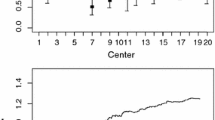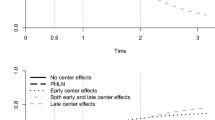Abstract
The competing risks data structure arises frequently in clinical and epidemiologic studies. In such settings, the cumulative incidence function is often used to describe the ultimate occurrence of a particular cause of interest. If the objective of the analysis is to compare subgroups of patients with respect to cumulative incidence, imbalance with respect to group-specific covariate distributions must generally be factored out, particularly in observational studies. This report proposes a measure to contrast center- (or, more generally group-) specific cumulative incidence functions (CIF). One such application involves evaluating organ procurement organizations with respect to the cumulative incidence of kidney transplantation. In this case, the competing risks include (i) death on the wait-list and (ii) removal from the wait-list. The proposed method assumes proportional cause-specific hazards, which are estimated through Cox models stratified by center. The proposed center effect measure compares the average CIF for a given center to the average CIF that would have resulted if that particular center had covariate pattern-specific cumulative incidence equal to that of the national average. We apply the proposed methods to data obtained from a national organ transplant registry.

Similar content being viewed by others
References
Andersen PK, Gill RD (1982) Cox’s regression model for counting processes: a large sample study. Ann Stat 10:1100–1120
Anderson PK, Borgan A, Gill RD, Keiding N (1993) Statistical models based on counting processes. Biometrics 24:100–101
Benichou J, Gail MH (1990) Estimates of absolute cause-specific risk in cohort studies. Biometrics 46:813–826
Breslow N (1972) Contribution to the discussion on the paper by D. R. Cox, regression and life tables. J R Stat Soc B 34:216–217
Cheng SC, Fine JP, Wei LJ (1998) Prediction of cumulative incidence function under the proportional hazards model. Biometrics 54:219–228
Chiang CL (1968) Introduction to stochastic processes in biostatistics. Wiley, New York
Cox DR (1959) The analysis of exponentially distributed lifetimes with two types of failure. J R Stat Soc B 21:411–421
Cox D (1972) Regression models and life-tables (with discussion). J R Stat Soc B 34:187–220
Cox D (1975) Partial likelihood. Biometrika 62:262–276
Crowder MJ (2001) Classical competing risks. Chapman and Hall/CRC Press, London
Dabrowska DM, Doksum KA (1988) Estimates and testing in a two-sample generalized odds-rate model. J Am Stat Assoc 83:744–749
DeLong ER, Peterson ED, DeLong DM, Muhlbaier LH, Hackett S, Mark DB (1997) Comparing risk-adjustment methods for provider profiling. Stat Med 16:2645–2664
Fine JP, Gray RJ (1999) A proportional hazards model for the subdistribution of a competing risk. J Am Stat Assoc 94:496–509
Fleming TR, Harrington DP (1991) Counting processes and survival analysis. Wiley, New York
Gail MH (1975) A review and critique of some models used in competing risk analysis. Biometrics 31:209–222
Gray RJ (1988) A class of K-sample tests for comparing the cumulative incidence of a competing risk. Ann Stat 16:1141–1154
Harrington DP, Fleming TR (1982) A class of rank test procedures for censored survival data. Biometrika 69(3):553–566
Kalbfleisch JD, Prentice RL (2002) The statistical analysis of failure time data. Wiley, Hoboken
Klein JP, Moeschberger ML (2003) Survival analysis. Springer, New York
Logan BR, Nelson GO, Klein JP (2008) Analyzing center specific outcomes in hematopoietic cell transplantation. Lifetime Data Anal 14(4):389–404
Moeschberger ML, David HA (1971) Life tests under competing causes of failure and the theory of competing risks. Biometrics 27:909–923
Prentice RL, Kalbfleisch JD, Peterson AV, Flournoy V, Farewell VT, Breslow NE (1978) The analysis of failure times in the presence of competing risks. Biometrics 34:541–554
Tsiatis AA (1975) A nonidentifiability aspect of the problem of competing risks. Proc Natl Acad Sci 72:20–22
Zhang MJ, Fine JP (2008) Summarizing differences in cumulative incidence functions. Stat Med 27:4939–4949
Zhang X, Zhang MJ (2011) SAS macros for estimation of direct adjusted cumulative incidence curves under proportional subdistribution hazards models. Comput Methods Programs Biomed 101:87–93
Acknowledgments
This research was supported in part by National Institutes of Health Grant 5R01-DK070869 (DES). The authors thank the Associate Editor and Reviewers for constructive suggestions which improved the manuscript. The authors also thank the Scientific Registry of Transplant Recipients (SRTR) for access to the organ transplant database. The SRTR is funded by a contract from the Health Resources and Services Administration (HRSA), U.S. Department of Health and Human Services. The views expressed in this report do not represent those of the U.S. Government.
Author information
Authors and Affiliations
Corresponding author
Appendix
Appendix
Proof of Theorem 2
The proof revolves around asymptotic expansions of the following quantities.
-
1.
\(n^{\frac{1}{2}}(\widehat{{\varvec{\beta }}}_k - {\varvec{\beta }}_k)\)
-
2.
\(n^{\frac{1}{2}}\left\{ \widehat{{\varLambda }}^\#_{0jk}(t)-{\varLambda }^\#_{0jk}(t) \right\} \)
-
3.
\(n^{\frac{1}{2}}\left\{ \widehat{{\varLambda }}^\#_{ijk}(t)-{\varLambda }^\#_{ijk}(t)\right\} \)
-
4.
\(n^{\frac{1}{2}}\left\{ \widehat{S}_{ij}(t)-S_{ij}(t) \right\} \)
-
5.
\(n^{\frac{1}{2}}\left\{ \widehat{F}_{ijk}(t) - F_{ijk}(t) \right\} \)
-
6.
\(n^{\frac{1}{2}} \left\{ \widehat{\delta }_{jk}(t) - \delta _{jk}(t) \right\} \)
[1] \(n^{\frac{1}{2}}(\widehat{{\varvec{\beta }}}_k - {\varvec{\beta }}_k)\)
By a Taylor expansion of \(U_k({\varvec{\beta }})\) around \({\varvec{\beta }}_k\),
where \({\varvec{U}}_{ik}({\varvec{\beta }})\) and \({\varvec{I}}_{k}({\varvec{\beta }})\) are as defined in the theorem. The result then follows from standard Martingale theory; e.g., Andersen and Gill (1982) and Fleming and Harrington (1991). Note that the processes \(M_{ijk}(t; {\varvec{\beta }}_1)\), for \(k=1,\ldots ,K\) are martingales with respect to the filtration
[2] \(n^{\frac{1}{2}} \left\{ \widehat{{\varLambda }}^\#_{0jk}(t)-{\varLambda }^\#_{0jk}(t) \right\} \)
We decompose the quantity as follows,
Since \(\widehat{{\varLambda }}_{0jk}^\#(t)\) is the Breslow–Aalen analog of \({\varLambda }_{0jk}^\#(t)\), we adapt results derived for the Breslow–Aalen estimator (Fleming and Harrington 1991). From this perspective, we can write
where the last equality holds by Slutsky’s Theorem. With respect to (7), we can write
since \(R_{jk}^{(0)}(t) {\rightarrow } r_{jk}^{(0)}(t)\) in probability. Putting (6) and (7) together, we get:
where \(\displaystyle {\varPhi }_{ijk}(t;{\varvec{\beta }}) = - {\varvec{h}}_{jk}^T (t;{\varvec{\beta }}) {\varvec{I}}_k({\varvec{\beta }})^{-1} {\varvec{U}}_{ik}({\varvec{\beta }}) + \int _0^t r_{jk}^{(0)} (s;{\varvec{\beta }}) ^{-1} dM_{ijk}(s; {\varvec{\beta }}). \)
[3] \(n^{\frac{1}{2}} \left\{ \widehat{{\varLambda }}^\#_{ijk}(t)-{\varLambda }^\#_{ijk}(t) \right\} \)
We start with the following decomposition,
By a Taylor expansion, then applying Result [1], we can write
where the last equality holds by the convergence in probability of \(\widehat{{\varLambda }}^\#_{ijk}(t)\) to \({\varLambda }^\#_{ijk}(t)\). We re-express (9) as
by incorporating Result [2], where we define
Combining (8) and (9), then further reorganizing, we obtain
where we let
[4] \(n^{\frac{1}{2}}\left\{ \widehat{S}_{ij}(t)-S_{ij}(t) \right\} \)
We decompose [4] as follows,
due to the Functional Delta Method, combined with the convergence, \(e^{-\widehat{{\varLambda }}^\#_{ijm}(s;\widehat{{\varvec{\beta }}}_m)} \rightarrow e^{-{\varLambda }^\#_{ijm}(s;{\varvec{\beta }}_m)}\), by continuity. Using Result [3], we then obtain
[5] \(n^{\frac{1}{2}} \left\{ \widehat{F}_{ijk}(t) - F_{ijk}(t)\right\} \)
We use the following decomposition,
where \({\varvec{\beta }}^T = [{\varvec{\beta }}_1^T, \ldots , {\varvec{\beta }}_K^T]\). Note that Eq. (10) will eventually give rise to \(\phi _{i\ell jk}^1(t, {\varvec{\beta }}), \phi _{i\ell jk}^2(t, {\varvec{\beta }})\) as defined in Theorem 2, while (11) will give rise to \(\phi _{i\ell jk}^3(t, {\varvec{\beta }})\) and \(\phi _{i\ell jk}^4(t, {\varvec{\beta }})\). We can write (10) as
where we have used Result [4]. Focusing on (12), we have,
by the fact that \(\widehat{{\varLambda }}^\#_{ijk}(s;{\varvec{\beta }}_k) {\rightarrow } {\varLambda }^\#_{ijk}(s;{\varvec{\beta }}_k) \), and \(\widehat{{\varvec{\beta }}}_k {\rightarrow } {\varvec{\beta }}_k \) and so, by the CMT, \(\widehat{{\varLambda }}^\#_{ijk}(s;\widehat{{\varvec{\beta }}}_k) {\rightarrow } {\varLambda }^\#_{ijk}(s;{\varvec{\beta }}_k). \) Therefore, from (12), define
Using analogous arguments, we can write
due to previously described properties of \(\widehat{{\varLambda }}^\#_{ijk}(s;{\varvec{\beta }}_k)\) and \(\widehat{{\varvec{\beta }}}_k\). Thus, from (13) define:
Now shifting attention to (11), we obtain
through Result [3]. We can then write
and, correspondingly, we define
We can re-express (15) as follows,
and, correspondingly redefine
Combining results derived in this subsection, we obtain,
where the \(\sum _{d=1}^4 \phi _{i\ell jk}^d(t, {\varvec{\beta }})\) are asymptotically independent and identically distributed variates with mean 0.
[6] \( n^{\frac{1}{2}} \left\{ \widehat{\delta }_{jk}(t) - \delta _{jk}(t) \right\} \)
We now complete the proof by averaging over \(i = 1, \ldots , n\) to obtain the limiting distribution of the proposed estimator. Setting \(n_j = \sum _{i=1}^n A_{ij}\) and \(p_j = E[A_{ij}]\), we have
Focusing on each component in (16), we have the following for the expression involving \(\phi ^1_{i\ell jk}(t;{\varvec{\beta }})\),
since \(n_j/n {\rightarrow } p_j\) by the Weak Law of Large Numbers (WLLN), continuity, and Slutsky’s Theorem. The simplification for the term involving \(\phi ^3_{i\ell jk}(t;{\varvec{\beta }}) \) unfold in a similar way. The term involving \(\phi ^2_{i\ell jk}(t;{\varvec{\beta }})\) can be written as the following:
by the WLLN, continuity, and Slutsky’s Theorem. The term involving \(\phi ^4_{i\ell jk}(t;{\varvec{\beta }}) \) unfold in a similar way. The term involving \(\phi ^1_{i\ell rk}(t;{\varvec{\beta }})\) can be written as the following:
The term involving \(\phi ^3_{i\ell rk}(t;{\varvec{\beta }})\) can be expressed in a similar way. The term involving \(\phi ^2_{i\ell rk}(t;{\varvec{\beta }})\) can be written as,
The term involving \(\phi ^4_{i\ell rk}(t;{\varvec{\beta }})\) can be expressed analogously. Therefore, we can write
All summands across \(l\) have mean 0 since the \(\phi \)’s have mean 0. If we apply the Functional Central Limit Theorem to [6], where each component is independent across \(l\), we have
Rights and permissions
About this article
Cite this article
Fan, L., Schaubel, D.E. Comparing center-specific cumulative incidence functions. Lifetime Data Anal 22, 17–37 (2016). https://doi.org/10.1007/s10985-015-9324-1
Received:
Accepted:
Published:
Issue Date:
DOI: https://doi.org/10.1007/s10985-015-9324-1




